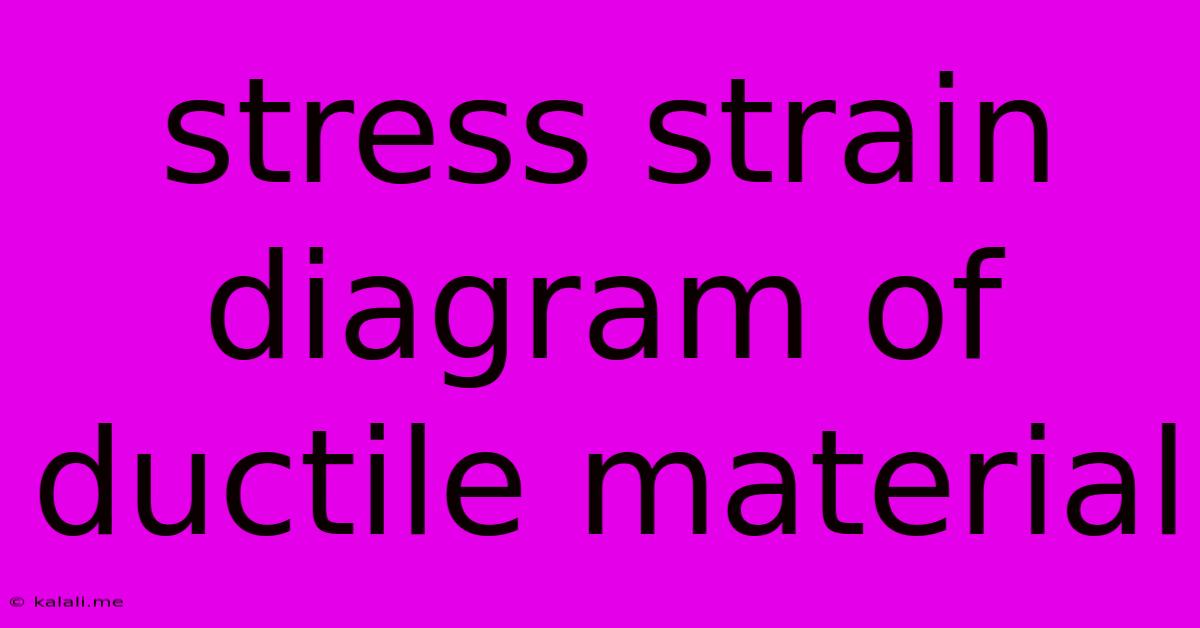Stress Strain Diagram Of Ductile Material
Kalali
Jun 12, 2025 · 3 min read

Table of Contents
Understanding the Stress-Strain Diagram of Ductile Materials
The stress-strain diagram is a fundamental tool in materials science, providing crucial insights into a material's mechanical behavior under load. This article will delve into the stress-strain diagram specifically for ductile materials, explaining its key features and the information it reveals. Understanding this diagram is vital for engineers selecting appropriate materials for various applications, ensuring structural integrity and safety.
What is a Stress-Strain Diagram?
A stress-strain diagram graphically represents the relationship between stress (the force applied per unit area) and strain (the deformation resulting from the applied stress) of a material. It's typically obtained through a tensile test, where a specimen is subjected to a controlled tensile force, and the resulting elongation is measured. The diagram provides a wealth of information about a material's strength, ductility, and elasticity.
Key Features of the Ductile Material Stress-Strain Diagram
Ductile materials, like mild steel or aluminum, are characterized by their ability to undergo significant plastic deformation before failure. Their stress-strain diagrams exhibit several distinct regions:
1. Elastic Region:
- This initial linear portion of the curve obeys Hooke's Law: stress is directly proportional to strain. The slope of this line represents the Young's Modulus (E), or modulus of elasticity, indicating the material's stiffness. The higher the Young's Modulus, the stiffer the material.
- In this region, the deformation is completely reversible; if the load is removed, the material returns to its original shape. The proportional limit marks the end of this perfectly elastic behavior.
2. Yield Point:
- Beyond the proportional limit, the material starts to deform plastically. This is often marked by a noticeable change in slope, representing the yield point. This is a crucial point because it signifies the onset of permanent deformation.
- The yield strength (σ<sub>y</sub>) is the stress at which plastic deformation begins. This is a critical parameter for design, as exceeding the yield strength can lead to permanent damage. Several methods exist for defining the yield point, including the 0.2% offset method.
3. Plastic Region:
- In this region, the material undergoes permanent deformation. The strain is no longer proportional to the stress, and the material will not return to its original shape upon unloading.
- The material exhibits strain hardening or work hardening in this region. This means that increasing stress is required to produce further plastic deformation as the material becomes stronger due to dislocation interactions.
4. Ultimate Tensile Strength (UTS):
- The highest point on the stress-strain curve represents the ultimate tensile strength (UTS). This is the maximum stress the material can withstand before necking begins.
5. Necking and Fracture:
- After reaching the UTS, the material starts to neck – a localized reduction in cross-sectional area. This leads to a decrease in the load-bearing capacity, and eventually, the material fractures. The stress at fracture is generally lower than the UTS.
Importance of Understanding the Stress-Strain Diagram
The stress-strain diagram is a vital tool for:
- Material Selection: Choosing the right material for a specific application based on its strength, ductility, and elasticity.
- Structural Design: Ensuring the structural integrity and safety of engineered components by staying within the material's allowable stress limits.
- Quality Control: Monitoring the consistency and quality of materials during manufacturing.
- Failure Analysis: Investigating the causes of material failure by analyzing the stress-strain behavior.
Conclusion:
The stress-strain diagram of ductile materials offers valuable insights into their mechanical properties. Understanding its key features – elasticity, yield point, plastic deformation, UTS, and fracture – is critical for engineers and materials scientists in diverse fields. This knowledge allows for informed material selection, robust design, and effective quality control, ultimately leading to safer and more reliable structures and products.
Latest Posts
Latest Posts
-
Which Is Bigger Gb Or Mg
Jun 13, 2025
-
Where Is The Most Mass Of An Atom Found
Jun 13, 2025
-
Moderate Frequency And Used In Remote Controls
Jun 13, 2025
-
Where Is The Transfer Case Located
Jun 13, 2025
-
How Do You Spell The Word 20
Jun 13, 2025
Related Post
Thank you for visiting our website which covers about Stress Strain Diagram Of Ductile Material . We hope the information provided has been useful to you. Feel free to contact us if you have any questions or need further assistance. See you next time and don't miss to bookmark.